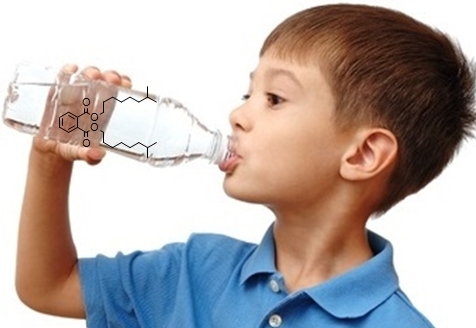
Problematic additives |
| Since many years, my dear wife has been molesting me with ironical remarks, whenever anything I eat or drink gets into prolonged contact with plastic. "Okay, so you are phthalating yourself once more..." (she is also a great inventor of words). Many chemicals rendering plastics (especially PVC) smoother and mechanically easier to treat are di-esters of phthalic acid. These additives, that can make up a considerable mass fraction of plastics, are astonishingly mobile and may exhibit surprising biological activities. Some of them have been banned from the market, but still many are in use. |
| When I realized during the last year that me and my students just had used up the last micro-Curie of radioligand and that under my new department director at the Center for Brain Research I could not expect any financial support in the near future, I thought it was a good idea to write a project. The Austrian Science Fund (FWF) is Austria's central funding organization for basic research. Therefore, I addressed myself to the FWF with a project entitled 'Influence of plastic additives on NMDA receptors: troubling research, endangering health'. |
| During my extensive literature research, I quickly 'caught fire'. I prepared 4 detailed tables with altogether 22 suspicious compounds, including their structural formulas and technical uses. I included own preliminary results illustrating, why we since many years suspect plastic additives to have influenced some of our binding experiments at the NMDA receptor (this receptor is crucial for learning and development). |
| I also scheduled a time table for 2 years, proposing 24 experimental approaches, the accommodation of 2 master students, and cooperation with a colleague from another department in the house, to bring in not only bare binding studies, but also physiologically more meaningful experiments with living cells and recording electrodes. I finally added a list with 46 expenses, from € 0 for a free sample of 100 g bis(2-ethylhexyl) succinate (a second generation plasticizer allegedly without unwanted side effects), up to € 5.500 for our main radioligand. |
| At the end, 46 references completed the application that, in its final form, extended to 22 pages (2 pages more than suggested by the FWF). Submission in its final form was completed by the end of October, and by the end of November the FWF - in a kind of pre-selection - decided to cancel my application ("... Ihren Antrag von der Liste der zu behandelnden Anträge abzusetzen..." - the letter was in German language). The letter brings forward 2 reasons for that: (1) The application is not based on a hypothesis ("...nicht hypothesengetrieben..."), and (2) it is not detailed enough ("...zu wenig detailliert ausgeführt..."). |
| After all I have told you about this project above, you may now wonder how the FWF came to this conclusion. I wonder too. This fascinating and (from a health perspective) possibly consequential story kept me busy for several weeks, and the FWF not even sends my application out for expert review. Now I understand how this funding organization (the only for basic research in Austria) comes to difficult decisions - difficult, because they do not have enough money (they have to reject 2 of 3 applications). Free-hand pre-selection without expert review is the solution. |
| It is only a pity that now, I probably will fail my secret main motivation for getting into this topic: collecting valuable arguments for my next dispute when my wife catches me in the act with another plastic drinking bottle. At least I will be able to cite passages from my application, if not from own experimental results. |
| 12/15 < MB
(1/16) > 2/16 Hardships of scientific research |
| McDonald
GR, Hudson AL, Dunn SMJ, You H, Baker GB, Whittal RM, Martin JW, Jha A,
Edmondson DE, Holt A (2008) Bioactive contaminants leach from
disposable laboratory plasticware. Science 322, 917. |